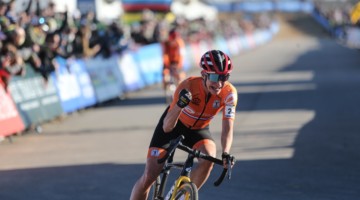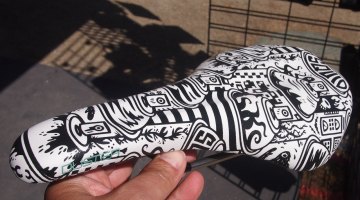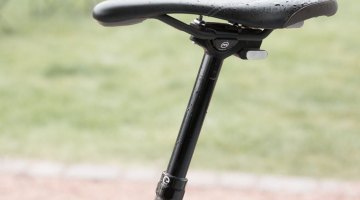While in Sedona, Arizona, at the Magura Ride Camp I had the opportunity to ride SQlab's new Ergowave saddle line. SQlab is another German brand that partnered with Magura USA for the Magura Ride Camp. And the saddle maker showed off its new Ergowave line, which aims to stand out from its competitors in terms of its fit options and comfort features, with race or performance-oriented weights and materials.

The SQlab Ergowave Active 611 saddle offers Kevlar crash protection, helpful on the rocky Sedona trails. Magura Ride Camp. © Cyclocross Magazine
SQlab - Focused on Fit
TheSQlab's claim to fame is that its saddles are offered in many widths. SQlab, back in 2002, was the first saddle manufacturer to introduce a system to measure sit bone distance to determine proper saddle width. While saddle makers that offer differing widths of the same model typically sell two or three different widths, SQlab offers its Ergowave saddle in four widths from 12cm to 15cm wide in 1cm increments.
How do you determine the proper width? The two biggest factors are sit bone width and riding style. SQlab offers a simple pressure-sensitive chair and paper that gives retailers and customers a quick, non-intrusive sit bone width measurement. Based on that and riding position, you'll be recommended a model and width. Kenny Roberts demonstrated how your riding position dictates saddle width, as the contact points of your sit bones gets wider the more upright you sit, warranting wider saddles for mountain biking than road cycling.
What's potentially confusing is that sit bone width does not equate to SQlab saddle width. My measurement was about 125.5mm, which translated into a 150mm 611 saddle width.

How big is your booty? Many of us don't know, but SQlab offers a simple measurement device and reference to help retailers and customers decide on the proper width. Magura Ride Camp. © Cyclocross Magazine
The rear of the Ergowave saddle features a prominent upward curve to provide support and, according to SQlab, ensures efficient power transmission. And while there is no cutout, there is a small dip in the saddle's center just in front of the rear's upward tilt to reduce pressure around the perineum.

The Ergowave saddle's nose sits lower and flatter than the saddle's rear. Photo courtesy: SQlab
The front of the saddle is long and level, with the saddle nose sitting well below the Ergowave's tail. This lower nose, while designed to relieve pressure for women and men alike, runs afould of UCI regulations requiring saddles to be level front to back. As a result, SQlab recommends those in UCI events running an Ergowave run their saddle slightly nose up.
There are two Ergowave models, the 612 meant for road use and the 611, which features Kevlar protection along the back of the saddle and is intended for all-round MTB use. There are also three different densities available for each model and various rail materials giving the saddles a claimed weight range of 147 grams to 275 grams.

Crash protection and length are two considerations in deciding between the SQlab Ergowave Active 611 and 612 saddles. The 611 (left) is longer and offers Kevlar crash protection for mountain bike use, while the 612 is aimed for road use. CX? Take your pick. Magura Ride Camp. © Cyclocross Magazine
SQlab Ergowave Active 612 and 611 Saddle Ride Impressions
Riding around the parking lot before a 41-mile hilly road ride, I was worried that I was in for a long day, as the 612 saddle certainly felt different over my favorites from Fabric and Fizik. However, just a few miles into the ride, I forgot I was riding a new saddle. And midway through the ride the saddle's Active system, with replaceable rubber bumpers, made it feel like I was riding a rear tire with a bit lower pressure. It's not marketed or advertised as suspension, as the Active system is designed to rotate a bit with the motion of your pelvis, but it felt as if it also absorbed some vibration. I'm anxious to get more time on a test saddle to see how it will do on gravel.
I also rode the longer, Kevlar-protected 611 on Sedona's trails, on a full suspension Intense Tracer 27.5 mountain bike. On the rocky terrain, in a more upright position, I definitely noticed the saddle more, and it was doing its job of concentrating my weight on my sit bones. By the end of the three-hour bumpy ride, I could tell that I had been riding a foreign saddle that I wasn't used to. It wasn't uncomfortable, but wasn't something my body was used to. I'm sure more saddle time would reveal whether the shape of 611 would meet my needs, but the width options were undoubtedly an asset (no pun intended) in aiding fit.
Pricing will range between $149-$249 depending on the saddle with various models becoming available over the next few months. Stay tuned as we hope to spend more time on these models on cyclocross and gravel rides.
SQlab: Aiming to Touch More than Butts
You may not have heard of SQlab, but the German company is a major player in bicycle accessories in Europe, and manufactures almost everything related to bicycle fit, including handlebars, grips, stems, pedals and shoe insoles.

SQLab is focused on optimizing ergonomics, and this 16 degree sweep back on its mountain bike handlebar is said to reduce stress on the upper body. Magura Ride Camp. © Cyclocross Magazine
The company showed off its 311 mountain bike handlebar. It's modern in terms of its width (740mm) and offers rise options, but differs in its 16 degree sweep back towards the rider. SQlab also offers a number of trekking and urban bars, including its own take on the mustache handlebar. Its mountain bike grips also focus on ergonomics, and the shape may remind some of the larger surface area grips from Ergon and Specialized.
The company, like Specialized, offers shoe insoles for different arch heights, and says the insoles don't take up any extra volume compared to stock shoe insoles.
More info: sq-lab.com
See all the new products and first ride reviews from the 2016 Magura Ride Camp here.






























